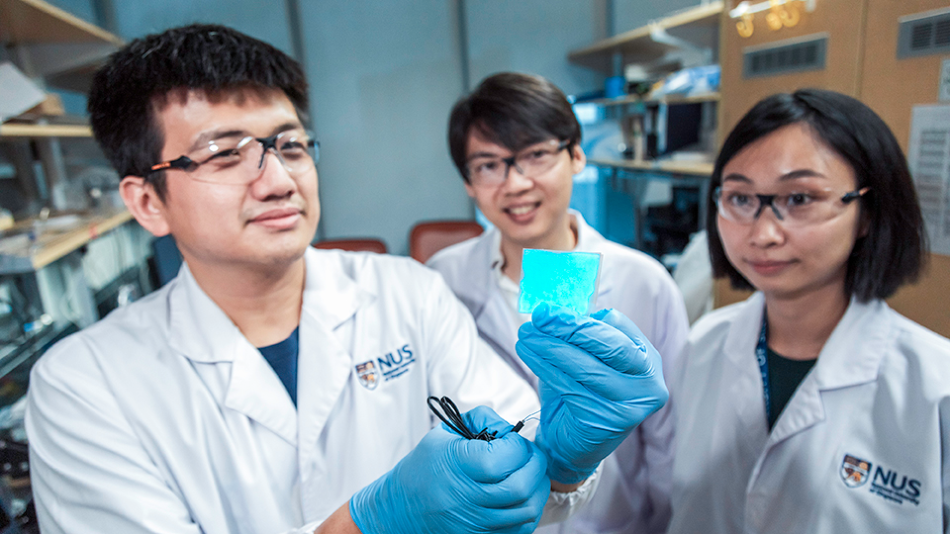Jun 1 2020
Envisage a stretchable digital screen that heals on its own when a crack develops, or a light-emitting robot that performs farming and space exploration work, or finds survivors in dark and hazardous locations.
 The NUS research team behind the novel electronic material is led by Assistant Professor Benjamin Tee (center). With him are two team members: Mr Wang Guanxiang (left), who is holding a sample of the illuminated material, and Dr Tan Yu Jun (right). Image Credit: National University of Singapore.
The NUS research team behind the novel electronic material is led by Assistant Professor Benjamin Tee (center). With him are two team members: Mr Wang Guanxiang (left), who is holding a sample of the illuminated material, and Dr Tan Yu Jun (right). Image Credit: National University of Singapore.
Thanks to an innovative material created by researchers from the National University of Singapore (NUS), these ideas could soon become a reality.
When added to light-emitting capacitor devices, the novel, stretchable material allows excellent visible illumination at relatively lower operating voltages. The material is also resistant to damage because of its self-healing characteristics.
Termed the HELIOS (which stands for Healable, Low-field Illuminating Optoelectronic Stretchable) device, this breakthrough was accomplished by Assistant Professor Benjamin Tee and his research group from the NUS Institute for Health Innovation & Technology and NUS Materials Science and Engineering. The study results were initially reported in Nature Materials—a leading scientific journal—on December 16th, 2019.
Durable, Low-Power Material for Next-Gen Electronic Wearables and Soft Robots
Conventional stretchable optoelectronic materials require high voltage and high frequencies to achieve visible brightness, which limits portability and operating lifetimes. Such materials are also difficult to apply safely and quietly on human-machine interfaces.
Benjamin Tee, Assistant Professor, Department of Electrical and Computer Engineering, National University of Singapore
The Department of Electrical and Computer Engineering is part of N.1 Institute for Health and the Hybrid Integrated Flexible Electronic Systems program.
To resolve these problems, the group comprising five NUS scientists started to examine and experiment with potential solutions in 2018, and after a year, it ultimately created the HELIOS.
To decrease the electronic operating conditions of flexible optoelectronic materials, the researchers developed a material that has excellent self-healing properties and high dielectric permittivity. The new material is an elastic, transparent rubber sheet containing a special combination of surfactant and fluoroelastomer.
Due to its high dielectric permittivity, the material can preserve more electronic charges at lower voltages, allowing a higher brightness when integrated into a light-emitting capacitor device.
HELIOS-enabled devices are different from prevalent stretchable light-emitting capacitors and can turn on at four times lower voltages and achieve over 20 times brighter illumination. The device also attained an illumination of 1460 cd/m2 at 2.5 V/µm—the brightest attained by any flexible light-emitting capacitor so far, and is currently equivalent to the brightness of cellular phone screens.
Thanks to its low power consumption, HELIOS can be powered wirelessly to enhance portability, can be used safely in human-machine interfaces, and can realize a longer operating lifetime.
In addition, HELIOS is impervious to punctures and tears. The reversible bonds that exist between the molecules of the material can be disintegrated and reformed, thus enabling the material to heal itself under ambient environmental conditions.
Eliciting the possible effect of HELIOS, Assistant Professor Tee added, “Light is an essential mode of communication between humans and machines. As humans become increasingly dependent on machines and robots, there is huge value in using HELIOS to create ‘invincible’ light-emitting devices or displays that are not only durable but also energy-efficient.”
“This could generate long-term cost savings for manufacturers and consumers, reduce electronic waste and energy consumption, and in turn, enable advanced display technologies to become both wallet and environmentally friendly,” he further added.
HELIOS, for instance, can be used to produce durable wireless displays that are resistant to damage. It can even work as an illuminating electronic skin for self-sufficient soft robots to be used for disaster zones, space missions, or smart indoor farming.
A self-repairing, low-power illuminating skin will offer safety lighting for the robot to navigate in the dark while staying operational for extended periods of time.
Next Steps
The NUS research group has now filed for a patent for the novel material, and is exploring ways to upgrade the new technology for wearable devices, safety lights, specialty packaging, robotics, and automotive applications.
Journal Reference:
Tan, Y. J., et al. (2020) A transparent, self-healing and high-κ dielectric for low-field-emission stretchable optoelectronics. Nature Materials. doi.org/10.1038/s41563-019-0548-4.
New stretchable, self-healing and illuminating electronic material for wearables and soft robots
Video Credit: National University of Singapore.